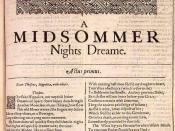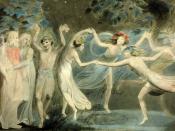The literary device of a story within another story has been around for years. As a dramatic device of a play within a play, it was first notably used by Thomas Kyd in his play The Spanish Tragedy in about 1587. This device, or conceit, has been used several times successfully by William Shakespeare in Love's Labours Lost, Hamlet, The Taming of the Shrew and A Midsummer Night's Dream. The conceit is used for several different purposes; contrast, mirroring and even purely comedic purposes. Shakespeare uses these ideas and more through the Rude Mechanicals in A Midsummer Night's Dream and through the traveling players in Hamlet (which is discussed less in this essay).
The first and most obvious use of the Rude Mechanicals in A Midsummer Night's Dream is strictly for the advancement of the main plot. While there are several sub and side plots, the main plot, as well as the one we are first introduced to, is the marriage between the Queen of the Amazons (Hyppolyta) and the Duke of Athens (Theseus).
The Rude Mechanicals are the men chosen to perform a play at the wedding ceremony of Theseus and Hyppolyta.
This first plot offers a secondary purpose for the Rude Mechanicals, contrast. The Rude Mechanicals are so called because of their positions. They are of a working class where their positions include a tinker, a weaver and a joiner. Puck is the first to refer to them as rude mechanicals in act three scene two; "rude mechanicals, that work for bread upon Athenian stalls," (139). Compared to the Duke and the Queen, these working men are pretty much the lowest in the play, even the fairies rank higher than they do. The class separation is extremely evident in the manner in which the different beings speak.


